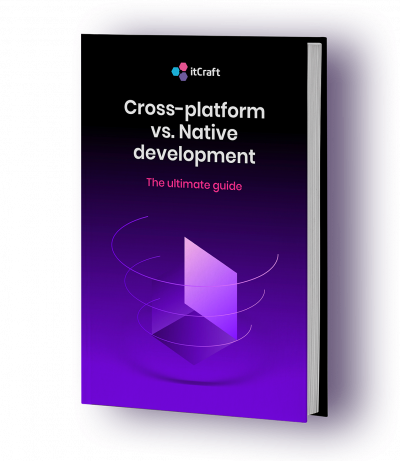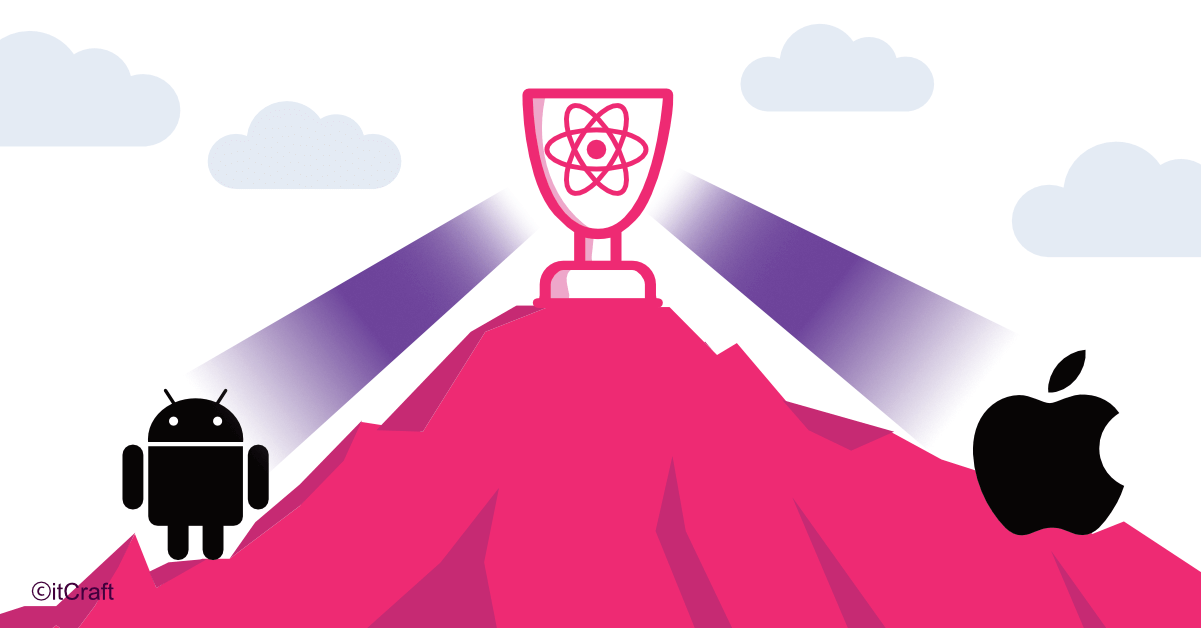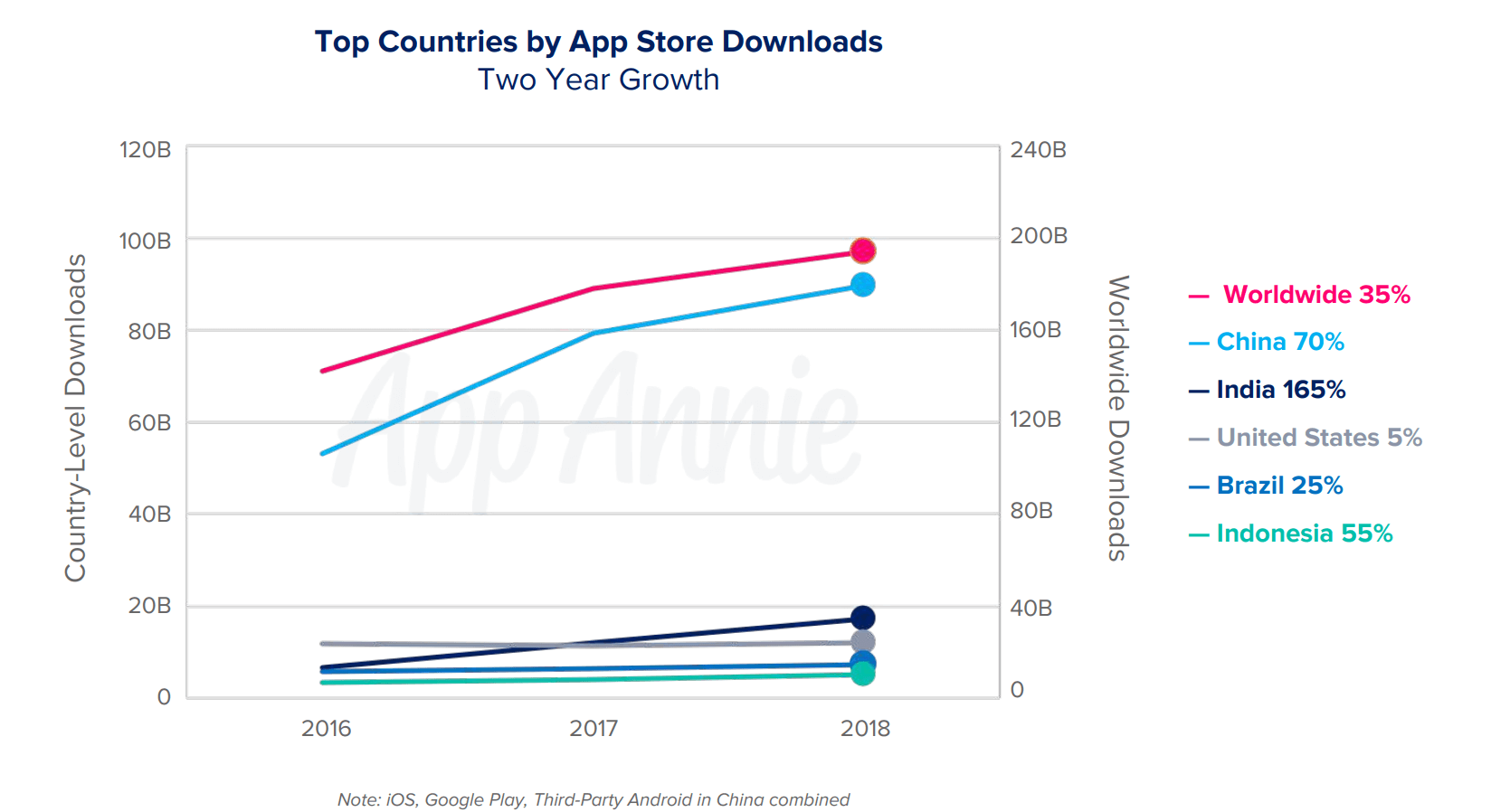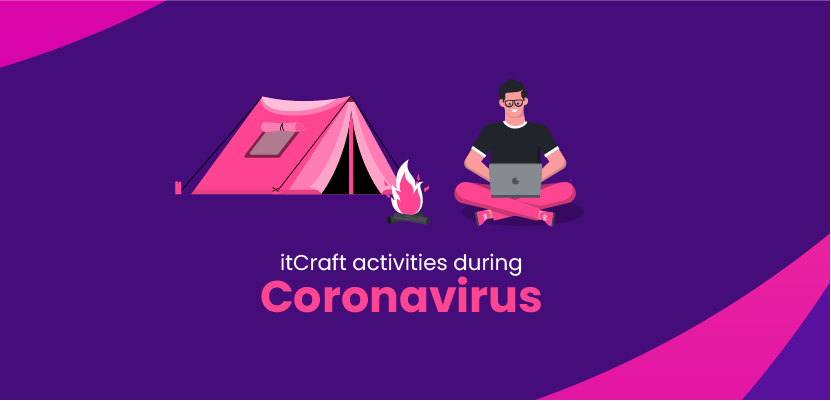Introduction to cross-platform app development

Alexa Trachim

Gareth Smith

One of the first questions that arises when building a digital product is which platforms should it be available on. Android has over 70% of the mobile market share, the demographic of iOS users leads to higher generated revenue and desktops and tablets still generate 40% of all website traffic. So the simple answer is “I want my app to be available on all platforms.” If there are no budget and time constraints, then building a native app for each platform is not an issue. However, this is rarely the case for most software development projects. The solution to this is cross-platform development. App development for multiple platforms is becoming a popular solution in the IT industry. So, let’s dive deeper into how cross-platform frameworks can help you maximise the opportunities of reaching all your customers no matter what device they prefer.
Table of contents
- What is a cross-platform app development?
- Native app development vs. cross-platform development
- What is the difference between a cross-platform and native app?
- Pros of cross-platform mobile apps development
– Cost efficiency
– Time efficiency
– Bigger market
– Code consistency - What is the best technology for cross-platform mobile development?
– Flutter in cross-platform development
– React Native in cross-platform development
– What is Xamarin? - Cross-platform app development – yes or no?
Building native Android & iOS apps has always been the best solution to take advantage of perfect user interface (UI) and all the in-built features of your Android or iOS device. However, this requires a native code base for each platform which increases the investment required into the software development process, maintenance costs and finding app developers who specialize in each programming language. For this reason, the rise in popularity of cross-platform frameworks has taken off over recent years allowing app developers the possibility to build one code base to deploy across multiple platforms. But are all cross-platform solutions built equally? The purpose of this article is to consider the pros and cons of cross-platform app development.
What is cross-platform app development?
The purpose of developing cross-platform apps is to deliver mobile applications that are suitable for more than one operating system. Cross-platform frameworks allow developers to render reusable code natively across different platforms. What does that actually mean? In simple words, developers use a cross-platform framework, like Flutter or React Native, to provide plug-ins, tools and the user interface components necessary for writing one code base to be deployed on any platform. The programming language, the complexity of the development process, the availability of a software development kit (SDK) and the viability of the mobile apps created are heavily dependent on which cross-platform framework is chosen. Currently, Flutter and React Native are by far the most popular cross-platform frameworks for commercially viable mobile apps but there are many other cross-platform frameworks available (see below).
Native app development vs. cross-platform app development
Native app development requires developers to create mobile apps from scratch using platform-specific programming languages. At itCraft, our developers code native Android apps in Kotlin (we also know Java), while iOS apps are developed in Swift (and sometime Objective-C). The beauty of building native apps is that the development process allows custom software development to leverage the full capabilities of the chosen mobile platform.
The trade-off for flawless performance, flexible customization and intuitive UX and UI is of course time and resources. However, in most cases where the deadline and budget are not the greatest constraints, building native apps is a ‘no-brainer’ and of course, for highly complex mobile apps requiring access to native elements of the device, apps processing a lot of data, or the high dependency on native APIs, then native app development is a must.
On the other hand, cross-platform app development has started to streamline the app development process by creating opportunities for significant cost and time savings, thus a better return on investment. In the past, cross-platform mobile development was not able to compete with native app development in terms of performance, UX and implementing consistent UI across all devices meaning cross-platform app development was only suitable for simple internal business apps rather than customer-facing apps which depended on excellent user experience.
However, in today’s software development landscape, the significant investment Meta has put into React Native, and Google has put into Flutter has seen choosing a cross-platform framework become a real commercially viable option for companies to achieve their business goals without the expense of native solutions. The performance achievable from React Native and Flutter, and in particular Flutter’s ability to achieve native-like UX means that a cross-platform solution will not compromise the ability to create mobile apps which can compete against native mobile and web apps.
In a previously released ebook, we explored the differences between native app development and cross-platform app development and interviewed CTOs and founders of companies who share their experience with cross-platform app development. We also dived deeper into cross-platform or native when developing apps. Download our ebook now to compare the difference between using a native framework or a cross-platform framework for your next software development project.
What is the difference between a cross-platform and native app?
App development is a significant investment for both startup founders and large enterprises alike, and choosing the right technology stack should be a consideration based on the commercial goals of your business. For example, a startup founder may be boot-strapping their MVP release to act as a proof-of-concept to the market and attract enough investment money to redesign and rebuild the product from scratch. In that scenario, the choice of programming language is probably not the highest priority. Whereas a CTO of a large telecommunications company will have to consider the right system architecture and technology stack to build a custom VoIP product and whether or not there is a commercial risk of having a heavy, customer-facing application which needs to be sustainable in the market for the next five or ten years built as a cross-platform app.
Cross-platform mobile apps use completely different development tools, programming languages and development frameworks to create apps which function on each operating system. Whereas a native solution has platform-specific, separate code for iOS, Android and other operating systems. The cross-platform development tools used to build a cross-platform app has both pros and cons in the development process against other native and web technologies. The average user probably won’t be able to tell the difference between native mobile apps and cross-platform mobile apps (if you have chosen the right cross-platform software developers). However, cross-platform app development has real implications on the development team and the maintainability of the software.
First, let’s consider the pros of cross-platform app development and then, how other cross-platform frameworks stack up against Flutter and React Native.
Pros of cross-platform mobile apps
Cross-platform apps offer many benefits that are appreciated by business owners. They explain why this technology becomes more widespread. Let’s see what the main pros of cross-platform mobile app development are:
Cost efficiency
Of course, if you have a budget, developing native solutions won’t be a problem. But cross-platform apps are perfect for companies that want to test their product with many customers or don’t have enough money to develop native apps. Some brands will even prefer a cross-platform app thanks to its consistent code that allows them to quickly implement changes and duplicate the app for more operating systems. Also, when developing a cross-platform app, the team size is much smaller – which can be another great way to save some money.
Time efficiency
If you need an app for iOS and Android that will be finished at the same time, cross-platform can be a much better choice than native. The teams that code separately can encounter different obstacles, which will cause uneven delays. With cross-platform development, the app is coded for all the platforms simultaneously, which saves tons of time. Native solutions are more complicated and demanding, so that’s another area where cross-platform apps can win regarding time efficiency.
Bigger market
Reaching a broader target audience is simple with cross-platform development. And that’s what you should aim for with your marketing strategy because device distribution is now much more diverse than it used to be. People use different operating systems, no matter what their location is. With a cross-platform app, you can offer your product to all of them.
Code consistency
As mentioned above, the reusable code in cross-platform mobile applications is one of the most significant advantages. Building an app for iOS & Android with a consistent code base is much more effective and allows more manageable future growth of the product. It prevents delays, too – because we don’t work with separate teams that usually produce a completely different code for native Android and iOS apps.
What is the best technology for cross-platform mobile development?
Based on the current forecasts and trending frameworks, the best mobile app development tools for cross-platform environments are Flutter, React Native and Xamarin. These technologies, made by Google, Facebook and Microsoft, are still pretty fresh in the world of software development, but they already changed the industry with their possibilities.
Determining which of these frameworks is the best might be impossible, but all of them have their advantages and drawbacks. Let’s see what their features are and what they can offer when it comes to cross-platform development.
Flutter in cross-platform development
Flutter became super popular in recent years. This framework, based on Dart programming language, offers almost native experience and uses customized widgets to build amazing user interfaces.
Why is Flutter appreciated so much by the cross-platform developers’ environment? Because it offers robust performance – probably the best from all frameworks within this area of software development. We’ve published Flutter review on our blog, where one of our cross-platform developers explains why this framework is so unique and how exactly it works.
To understand better why Flutter became such a sensation, we need to analyze its functionalities. Dart, an object-oriented language, allows us to write asynchronous code as it was synchronous. What does it mean? This way, a developer can complete specific tasks while others are still not finished.
Another great thing about Flutter is it’s documentation. It is clear, intuitive and consistent – so all the devs that need to use it can quickly find what they need. That’s not always the case with older frameworks.
Building apps with stunning UI is another goal that everyone wants to accomplish. That’s because user interfaces are what people interact with. They need to be user-friendly, embedded in context and bring out the brand’s vibe. When it comes to Flutter, creating flawless UI is a piece of cake. That’s because it is based on widgets that can be rebuilt when a need for change occurs. This rebuilding process doesn’t mean we need to code everything from scratch – the framework modifies the widgets itself when it receives new pieces of information in the codebase.
Cross-platform development is easy and fun with Flutter. That’s why it’s often recommended for both iOS and Android apps. But it has competition – and it’s a strong one. On our blog you can read a thorough article on Flutter vs. React Native. Let’s see why cross-platform mobile app developers also like React Native.
React Native in cross-platform app development
React Native framework has been around much longer than Flutter and it’s unquestionably one of the leading technologies in cross-platform development. It runs on JavaScript and uses UI components for interfaces.
The UI design using React Native is particularly impressive. The elements are bound to the native components that match the operating systems we are developing the app for. These components are the pillar of React Native cross-platform mobile app development.
React Native as an open-source framework released by Facebook gets constant support from the community and the brand itself. It is regularly updated and the number of libraries available to develop specific features is rapidly growing. That’s why choosing this mobile app development framework to make products for multiple platforms is a wise choice.
Implementing changes fast is what matters when choosing development tools – especially in times of pandemic or other global crises that need fast reaction time from brands. They need to propose new features in no time, so they can stay afloat no matter how the conditions in society are changing. With native mobile apps that can be extremely difficult. But not with cross-platform development using React Native.Adding new things to the existing app happens almost immediately with live reload functionality. Recompiling the application after applying changes to the code occurs almost instantly.
What is Xamarin?
Cross-platform mobile development platforms are diverse, but usually, the two mentioned above are discussed most intensely. But there are other solutions for building apps for multiple platforms – and one of them is Xamarin by Microsoft.
Xamarin apps share the majority of their codebase – so whichever operating system you pick for development, it is much less complicated. It is based on .NET framework and uses C# programming language. What’s interesting, it can connect with the native code of iOS & Android to achieve even more robust performance and provide functionalities that are available specifically for them – for example, PayPal integration or Google Analytics module.
Cross-platform development should be seamless for every operating system, including wearable devices. Xamarin supports development for Apple watches, as well as wearables based on Android. It’s universal nature is what distinguishes it among similar platforms.
User experience in Xamarin-based apps is very similar to native – and that means just positive, user-friendly and intuitive. That’s thanks to specific UI components fitted to an operating system of choice and to hardware support that allows us to make use of all the device functionalities we desire to.
The main advantage of Xamarin over other mentioned cross-platform development technologies is its code reusability. Most of these platforms are similar and have the solutions figured out in one or the other way. Choosing the right platform is a question of the available team. If you are collaborating with an experienced software house, they will definitely give you a couple of options to choose from. Also, they usually hire a pool of experts and specialists in cross-platform development, so no matter which platform they use – they will be able to achieve results for your business.
Cross-platform development – yes or no?
You should definitely consider it. In the fast-paced world where time is money and everyone has big ideas but not so often a big budget – developing complex apps for iOS, Android and all other platforms (no matter if mobile or web) is one of the elements that can bring success for your brand. Offer your customers a solution that can fix their problems, deliver your products and services, or just be something they will cherish for inspiration and entertainment.

With cross-platform development, your app can hit the market in many places around the world in no time. If you still want to educate yourself in that matter – download our ebook on native app development and cross-platform app development. It’s a comprehensive guide for everyone who is interested in mobile app development and wants to build a product that will fulfill all their business needs. Our specialists from itCraft share their knowledge and expertise to give you tons of information about our passion and our daily work – mobile apps.
And if you are thinking about doing a software development project and you are looking for an IT company that knows what they’re doing – let us know what you have in mind! We are open to intriguing projects and exciting collaborations.





